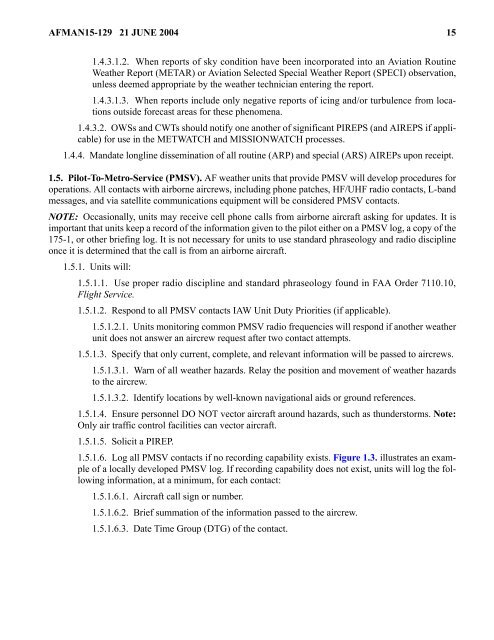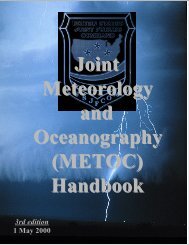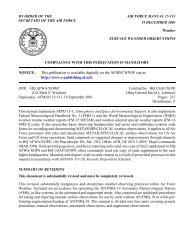Air and Space Weather Operation - IHMC Ontology and Policy ...
Air and Space Weather Operation - IHMC Ontology and Policy ...
Air and Space Weather Operation - IHMC Ontology and Policy ...
You also want an ePaper? Increase the reach of your titles
YUMPU automatically turns print PDFs into web optimized ePapers that Google loves.
AFMAN15-129 21 JUNE 2004 151.4.3.1.2. When reports of sky condition have been incorporated into an Aviation Routine<strong>Weather</strong> Report (METAR) or Aviation Selected Special <strong>Weather</strong> Report (SPECI) observation,unless deemed appropriate by the weather technician entering the report.1.4.3.1.3. When reports include only negative reports of icing <strong>and</strong>/or turbulence from locationsoutside forecast areas for these phenomena.1.4.3.2. OWSs <strong>and</strong> CWTs should notify one another of significant PIREPS (<strong>and</strong> AIREPS if applicable)for use in the METWATCH <strong>and</strong> MISSIONWATCH processes.1.4.4. M<strong>and</strong>ate longline dissemination of all routine (ARP) <strong>and</strong> special (ARS) AIREPs upon receipt.1.5. Pilot-To-Metro-Service (PMSV). AF weather units that provide PMSV will develop procedures foroperations. All contacts with airborne aircrews, including phone patches, HF/UHF radio contacts, L-b<strong>and</strong>messages, <strong>and</strong> via satellite communications equipment will be considered PMSV contacts.NOTE: Occasionally, units may receive cell phone calls from airborne aircraft asking for updates. It isimportant that units keep a record of the information given to the pilot either on a PMSV log, a copy of the175-1, or other briefing log. It is not necessary for units to use st<strong>and</strong>ard phraseology <strong>and</strong> radio disciplineonce it is determined that the call is from an airborne aircraft.1.5.1. Units will:1.5.1.1. Use proper radio discipline <strong>and</strong> st<strong>and</strong>ard phraseology found in FAA Order 7110.10,Flight Service.1.5.1.2. Respond to all PMSV contacts IAW Unit Duty Priorities (if applicable).1.5.1.2.1. Units monitoring common PMSV radio frequencies will respond if another weatherunit does not answer an aircrew request after two contact attempts.1.5.1.3. Specify that only current, complete, <strong>and</strong> relevant information will be passed to aircrews.1.5.1.3.1. Warn of all weather hazards. Relay the position <strong>and</strong> movement of weather hazardsto the aircrew.1.5.1.3.2. Identify locations by well-known navigational aids or ground references.1.5.1.4. Ensure personnel DO NOT vector aircraft around hazards, such as thunderstorms. Note:Only air traffic control facilities can vector aircraft.1.5.1.5. Solicit a PIREP.1.5.1.6. Log all PMSV contacts if no recording capability exists. Figure 1.3. illustrates an exampleof a locally developed PMSV log. If recording capability does not exist, units will log the followinginformation, at a minimum, for each contact:1.5.1.6.1. <strong>Air</strong>craft call sign or number.1.5.1.6.2. Brief summation of the information passed to the aircrew.1.5.1.6.3. Date Time Group (DTG) of the contact.




